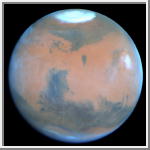|
COMETS EARTH JUPITER KUIPER BELT MARS MERCURY METEORITES NEPTUNE OORT CLOUD PLUTO SATURN SOLAR SYSTEM SPACE SUN URANUS VENUS ORDER PRINTS
PHOTO CATEGORIES SCIENCEVIEWS AMERICAN INDIAN AMPHIBIANS BIRDS BUGS FINE ART FOSSILS THE ISLANDS HISTORICAL PHOTOS MAMMALS OTHER PARKS PLANTS RELIGIOUS REPTILES SCIENCEVIEWS PRINTS
|
Related Document
Download Options
This NASA Hubble Space Telescope view of the planet Mars is one of the clearest pictures ever taken from Earth, surpassed only by close-up shots sent back by visiting space probes. The picture was taken on February 25, 1995, when Mars was at a distance of approximately 65 million miles (103 million km) from Earth. Because it is spring in Mars' northern hemisphere, much of the carbon dioxide frost around the permanent water-ice cap has sublimated, and the cap has receded to its core of solid water-ice several hundred miles across. The abundance of wispy white clouds indicates that the atmosphere is cooler than seen by visiting space probes in the 1970s. Morning clouds appear along the planet's western (left) limb. These form overnight when Martian temperatures plunge and water in the atmosphere freezes out to form ice-crystal clouds. The dark "shark fin" feature left of center is Syrtis Major. Below it the giant impact basin Hellas. Clouds cover several great volcanos in the Elysium region near the eastern (right) limb. As clearly seen in the Hubble images, past dust storms in Mars' southern hemisphere have scoured the plains of fine light dust and transported the dust northward. This leaves behind a relatively coarser, and less reflective sand in, predominantly, the southern hemisphere. This picture was taken with Hubble's Wide Field Planetary Camera 2 in PC mode. Exposures were taken through three different color filters to create this true color image. The pictures were map-projected onto a sphere for accurate registration and perspective.
Credit: Philip James (University of Toledo),
Steven Lee (University of Colorado),
NASA
|
